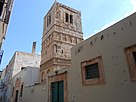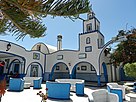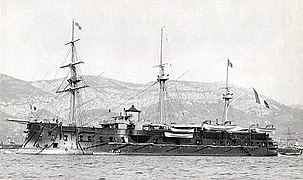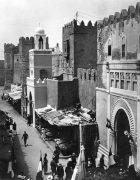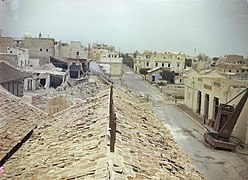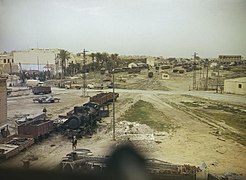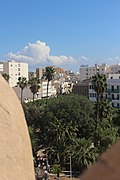Sfax
Sfax
صفاقس | |
|---|---|
Clockwise from top: View of Sfax from Ksar Ben Romadhane, Cafe Sidi Boussaid, Sfax Governorate headquarters, Dar Jellouli Museum, Avenue Farhat Hached, City Walls, Sidi Amor Kammoun Mosque | |
| Coordinates: 34°44′24″N 10°45′36″E / 34.74000°N 10.76000°E | |
| Country | |
| Governorate | Sfax Governorate |
| Delegation(s) | Sfax West, Sfax South, Sfax Medina |
| Established | AD 849 |
| Elevation | 0 m (0 ft) |
| Population (2022) | |
| • City | 341,999 |
| • Metro | 1,018,341 |
| Time zone | UTC+1 (CET) |
| • Summer (DST) | UTC+1 |
Sfax (/s(ə)ˈfæks/ s(ə-)FAKS; Arabic: صفاقس, romanized: Ṣafāqis, Tunisian Arabic: [ˈsˤfaːqəs] ) is a city in Tunisia, located 270 km (170 mi) southeast of Tunis. The city, founded in AD 849 on the ruins of Taparura, is the capital of the Sfax Governorate (about 955,421 inhabitants in 2014),[citation needed] and a Mediterranean port. Sfax has a population of 341,999 (census 2022).[1] Its main industries include phosphate, olive and nut processing, fishing (it is the largest fishing port in Tunisia) and international trade. The city is the second-most populous in the country after the capital, Tunis.[2]
History
[edit]Carthaginian and Aghlabid eras
[edit]Present-day Sfax was founded by the Aghlabids in AD 849 on the site of the town of Taparura. The modern city has also grown to cover some other ancient settlements, most notably Thenae in its southern suburb of Thyna.
Almohad era
[edit]By the end of the 10th century, Sfax had become an independent city-state. The city was conquered by Roger II of Sicily in 1148 and occupied until it was liberated in 1156 after a revolt and taken by the Almohads, and was briefly occupied by European forces again, this time by the Spanish, in the 16th century, before falling into Ottoman hands. Sfax became an integral base of the Barbary piracy, prompting an unsuccessful invasion by Venice in 1185.
Hafsid era
[edit]Abou Yahya Abou Bekr finally re-established Hafsid unity and recaptured Kerkennah from the Christians in 1335. The peace returned to the country was only disturbed by rare episodes, the most lasting of which began with the price of Sfax by the dissident brothers, Ahmed and Abdelmalèk ben Makki.[citation needed]
Towards 1370, following the arrival of Caliph Abdul-Abbas, Sfax returned under the Hafsid era.[citation needed]
After more than three centuries, which had seen the preponderance of the Hafsids, the conflict between the Turks and the Spaniards precipitated the fall of their dynasty. In 1534, the privateer Barberousse entered Tunis, proclaimed the decline of the Hafsids and effortlessly reunited the towns of the coast, among them the town of Sfax.[3]
Husseinid era
[edit]The founder of the new dynasty, Hussein, gave the country unquestionable economic prosperity. In Sfax, the mosque is enlarged, which regains its original extent; the new mihrâb is dated 1758, the work was completed in 1783.[citation needed]
The ramparts were restored and two large reservoirs were built to supplement the Nasriah cisterns. In 1776, the southern suburb of the city, the Frankish quarter, was built, reserved for Jews and Christians, a major place of maritime trade, but which was also to serve as a buffer against sea attacks, which were still to be feared. The eventuality was not long in coming, the Venetians bombarding Sfax four times in the space of two years (1785–86). A large fort was built during the siege to flank Borj Ennar; it was demolished after the last war.[citation needed]
Around 1830, the Frankish quarter was surrounded by a wall and in 1860 the city had a post office and telegraph. In 1876, the telegraph clerk made a plan of the city and told us about a signal tower built a century earlier and of which we have lost track.[3]
French era
[edit]When the Bey of Tunis signed the Bardo Treaty, in 1881, making Tunisia a protectorate, an insurrection broke out in Sfax. Six ironclads were dispatched from Toulon (Colbert, Friedland, Marengo, Trident, Revanche, Surveillante) to join the French Navy ships in Tunisian waters. In Sfax, three ironclads from the Division of the Levant were already present (Alma, Reine Blanche, La Galissonnière), together with four cannon boats.[4] Sfax was bombarded, and on 16 July the city was taken by the French after hard fighting, with seven dead and 32 wounded for the French.[5]
World War II
[edit]During World War II, the Axis powers used the city as a major base until British forces took it on 10 April 1943. After World War II, Tunisia was returned to France, but gained independence in 1956.
- historical images
-
The French ironclad Colbert which bombarded Sfax (1881)
-
Bab Diwan (1890)
-
Colonel Bougrain and Léon Beaufils in Sfax (1934)
-
British Army in Tunisia (1943)
-
Les Salines of Sfax (1910)
-
German prisoners (1946)
-
Bab Diwan and Old view of Sfax (1954)
-
Street in Sfax after an Allied bombing raid in June 1943
-
Train yard in Sfax after an Allied bombing raid in June 1943
-
Warehouses near the port of Sfax after an Allied bombing raid in June 1943
Geography
[edit]Climate
[edit]Sfax has a hot semi-arid climate (Köppen BSh). Owing to its sheltered location relative to Mediterranean Sea winter storms, Sfax receives half the rainfall of Tunis and less even than the major cities of Libya (Tripoli and Benghazi). Summers, like all of North Africa, are hot and almost rainless, whilst winters are very pleasant with usually only light rain.
| Climate data for Sfax (1991–2020, extremes 1950–present) | |||||||||||||
|---|---|---|---|---|---|---|---|---|---|---|---|---|---|
| Month | Jan | Feb | Mar | Apr | May | Jun | Jul | Aug | Sep | Oct | Nov | Dec | Year |
| Record high °C (°F) | 26.8 (80.2) |
32.7 (90.9) |
36.9 (98.4) |
37.2 (99.0) |
41.3 (106.3) |
47.8 (118.0) |
47.2 (117.0) |
46.8 (116.2) |
43.5 (110.3) |
38.6 (101.5) |
34.5 (94.1) |
28.7 (83.7) |
47.8 (118.0) |
| Mean daily maximum °C (°F) | 17.5 (63.5) |
18.1 (64.6) |
20.4 (68.7) |
22.8 (73.0) |
26.3 (79.3) |
30.2 (86.4) |
32.8 (91.0) |
33.4 (92.1) |
30.5 (86.9) |
27.3 (81.1) |
22.6 (72.7) |
18.7 (65.7) |
25.1 (77.2) |
| Daily mean °C (°F) | 12.1 (53.8) |
12.7 (54.9) |
15.1 (59.2) |
17.8 (64.0) |
21.3 (70.3) |
25.0 (77.0) |
27.6 (81.7) |
28.4 (83.1) |
26.1 (79.0) |
22.6 (72.7) |
17.4 (63.3) |
13.4 (56.1) |
20.0 (68.0) |
| Mean daily minimum °C (°F) | 6.8 (44.2) |
7.2 (45.0) |
9.8 (49.6) |
12.7 (54.9) |
16.3 (61.3) |
19.9 (67.8) |
22.4 (72.3) |
23.3 (73.9) |
21.7 (71.1) |
17.9 (64.2) |
12.2 (54.0) |
8.2 (46.8) |
14.9 (58.8) |
| Record low °C (°F) | −2.3 (27.9) |
−1.2 (29.8) |
−1.0 (30.2) |
2.0 (35.6) |
6.1 (43.0) |
10.6 (51.1) |
13.6 (56.5) |
13.2 (55.8) |
11.2 (52.2) |
5.2 (41.4) |
2.0 (35.6) |
−1.0 (30.2) |
−2.3 (27.9) |
| Average precipitation mm (inches) | 23.9 (0.94) |
15.3 (0.60) |
27.5 (1.08) |
17.3 (0.68) |
13.7 (0.54) |
6.1 (0.24) |
1.0 (0.04) |
6.3 (0.25) |
33.8 (1.33) |
24.8 (0.98) |
21.7 (0.85) |
26.0 (1.02) |
217.4 (8.55) |
| Average precipitation days (≥ 1.0 mm) | 2.8 | 2.5 | 3.3 | 2.6 | 1.7 | 0.8 | 0.1 | 0.9 | 3.1 | 2.9 | 2.5 | 2.9 | 26.3 |
| Average relative humidity (%) | 65 | 63 | 63 | 63 | 62 | 60 | 59 | 63 | 65 | 66 | 65 | 66 | 63 |
| Mean monthly sunshine hours | 191.8 | 202.7 | 231.2 | 251.6 | 306.6 | 338.1 | 369.8 | 335.8 | 254.3 | 225.4 | 208.4 | 193.2 | 3,108.9 |
| Mean daily sunshine hours | 6.4 | 7.2 | 7.7 | 8.6 | 10.0 | 11.1 | 12.2 | 11.2 | 9.1 | 7.8 | 7.0 | 6.3 | 8.7 |
| Source 1: Institut National de la Météorologie (humidity 1961-1990, sun 1981–2010)[6][7][8][9][note 1] | |||||||||||||
| Source 2: NOAA (humidity/daily sun 1961–1990)[11][12][13] | |||||||||||||
| Jan | Feb | Mar | Apr | May | Jun | Jul | Aug | Sep | Oct | Nov | Dec |
|---|---|---|---|---|---|---|---|---|---|---|---|
| 16 °C (61 °F) | 15 °C (59 °F) | 15 °C (59 °F) | 17 °C (63 °F) | 19 °C (66 °F) | 22 °C (72 °F) | 26 °C (79 °F) | 28 °C (82 °F) | 27 °C (81 °F) | 25 °C (77 °F) | 22 °C (72 °F) | 18 °C (64 °F) |
Topography
[edit]The topography of the governorate of Sfax tilts regularly from the west to the coast and local presents small hills and mountain ranges in the form of elongated draâs.

Relief
[edit]Sfax is characterized by a monotonous, low and slightly uneven relief. The altitude y rarely exceed 250 m, especially in the center-west of the governorate (Draâ Lahirech, 269 m; Djebel Chebka, 255 m). Most of the study site extends over wide plains not exceeding the 150 m above sea level, including a low coastal strip about 15 km wide and having an average altitude of 20 m.[15]
Hydrography
[edit]The monotonous character, low and not very rugged of the topography largely determined the characteristics hydrographic in the governorate of Sfax. Indeed, the rivers are numerous, shallow and rarely reaches the sea. The hills and small mountain ranges of the center-west present a hydrographic hairline dense and relatively deep compared to the coastal strip. Like a few exoreic rivers (wadi Agareb, wadi Laâchech, wadi El Maleh), most of the Wadis are endorheic, leading to closed depressions of the sebkhas and garâas type. Depending on their morpho-structural conditions, these closed depressions take the form of basins synclinal (Menzel Chaker and Hancha regions) or the form of sebkhas and garâas (Noual, Bou Jmal, Mchiguigue, Karafita... etc.).[16]
Neighborhoods
[edit]Whether in the city center or between the radial roads, there are large, popular neighborhoods in Sfax, most of which are:
- Hay El Rabdh
- Hay El Habib
- Hay El Bahri
- Hay Bourguiba
- Hay El Badrani
- Hay Ennasr
- Hay El Maez
- Hay Thyna
Politics and administration
[edit]Mayor and municipality
[edit]| Mayor | Party | Start of mandate | End of mandate |
|---|---|---|---|
| Abdelatif Chaker | 1956 | 1957 | |
| Mohamed Makni | 1957 | 1960 | |
| Abdelmajid Chaker | 1960 | 1966 | |
| Sadok Guermazi | 1966 | 1975 | |
| Tijani Makni | 1975 | 1980 | |
| Ahmed Bellassoued | 1980 | 1985 | |
| Ahmed Zeghal | 1985 | 1990 | |
| Mohamed Chaker | 1990 | 1995 | |
| Mohamed El Hadj Tayeb | 2000 | 2010 | |
| Moncef Abdelhedi | 2010 | 2011 | |
| Mohamed Najib Abdelmoula | 2011 | 2012 | |
| Mabrouk Kessentini | 2012 | 2017 | |
| Imed Sebri | 2017 | 2018 | |
| Hamza Dhahri | 2018 | 2018 | |
| Mounir Elloumi | Ennahdha | 2018 | now |
-
Sadok Ghermazi
-
Abdelmajid Chaker
-
Mohamed Chaker

The current mayor of the city is Mounir Elloumi (belonging to Ennahdha), elected in the 2018 Tunisian local elections[18]
| Party | Seats |
|---|---|
| Ennahdha | 14 |
| Nidaa Tounes | 7 |
| Democratic Current | 8 |
| Front populaire | 2 |
| Other movement | 9 |
| Independent movement | 2 |
| Total | 42 |
Administrative division
[edit]
The Governorate of Sfax has 16 municipalities :
| Code | Municipality | Population (2014)[19] |
|---|---|---|
| 3411 | Sfax | 272,801 |
| 3412 | Sakiet Ezzit | 53,243 |
| 3413 | Chihia | 26,300 |
| 3414 | Sakiet Eddaïer | 45,767 |
| 3415 | Gremda | 40,858 |
| 3416 | El Ain | 43,337 |
| 3417 | Thyna | 33,419 |
| 3418 | Agareb | 11,513 |
| 3419 | Jebiniana | 7,190 |
| 3420 | El Hencha | 7,575 |
| 3421 | Menzel Chaker | 2,278 |
| 3422 | Ghraïba, Tunisia | 3,251 |
| 3423 | Bir Ali Ben Khélifa | 4,905 |
| 3424 | Skhira | 11,912 |
| 3425 | Mahares | 15,878 |
| 3426 | Kerkennah | 15,501 |
Demographics
[edit]| Year | Pop. | ±% |
|---|---|---|
| 1993 | 714,900 | — |
| 2006 | 881,000 | +23.2% |
| 2007 | 893,000 | +1.4% |
| 2008 | 905,000 | +1.3% |
| 2009 | 906,129 | +0.1% |
| 2010 | 916,190 | +1.1% |
| 2011 | 926,363 | +1.1% |
| 2012 | 936,647 | +1.1% |
| 2013 | 947,046 | +1.1% |
| 2014 | 958,100 | +1.2% |
| 2015 | 971,300 | +1.4% |
| 2016 | 983,300 | +1.2% |
| 2017 | 995,300 | +1.2% |
| 2019 | 1,013,021 | +1.8% |
In 2019, the population of Sfax has reached 1,013,021 inhabitants. The urban population represents 63.7% of the population.[20] In 2014 the Males represent 50.2% of the population structure with a population of 140,752. As to the Females, they represent 49.1% with a population of 139,814.[21]
Architecture and urbanism
[edit]Medina
[edit]The Medina represents one of the most important quarters of Sfax. it plays a touristic and historical role of the city. It was built by Aghlabid prince Abu Abbass Muhammad between 849 and 851. The medina is home to about 113,000 residents and is dominated by the Great Mosque of Sfax.
Walls and gates
[edit]
Apart from Borj Ennar and three other towers that disappeared, the walls of the medina kept the same original architecture since 1306.[22] These are 2,750 meters long and have 34 dungeons. Their height varies between seven and eleven meters.[22]
Originally, the medina had only two doors: Bab Jebli, also known as Bab Dhahraoui (northern door), and Bab Diwan or Bab Bahr (the sea door). Yet, in the 20th century and because of the economic development and the huge increase of the population, new doors had to be created to reduce the flow from these two main doors such as Bab El Ksar and Bab Jebli Jedid.[23]
Kasbah
[edit]
Like most of the other medinas of Tunisia, Sfax has its own kasbah. It is a desert fortress, located in the southwestern corner of the medina. It was used for different purposes throughout history, first, a control tower built by the Aghlabids on the coast, then the seat of the municipal government, and then the main army barracks. Its construction was preceded by the deployment of the wall and the medina quarter. Today it is served as a museum of traditional architecture.[24]
Mausoleums and mosques
[edit]Also here are the Sidi Amar Kammoun Mausoleum, Sidi Ali Ennouri Mausoleum, Sidi Belhassen Karray Mausoleum, El Ajouzine Mosque, Bouchouaicha Mosque, Driba Mosque and Sidi Elyes Mosque.
City hall
[edit]The city hall of Sfax is in the center of the modern city and opens on Habib Bourguiba Street in parallel with the main entrance of the historic city. The Municipal Palace draws attention to the magnificence and beauty of its exterior architecture and its interior decorations and masterpieces. This unique landmark was designed by French architect Rafael Guy, who blended the Arab-Moriscan character with the European character The project of the construction of the Palace of the scourge began at the beginning of the twentieth century, where the municipality issued a tender for this purpose in the newspaper Adebash Svaxian on 30 June 1904 and began construction works in late 1905 and ended in 1906 In 1912, he began to expand gradually until around 1943 After the Second World War, the town hall was completed in 1955.[25]
Cityscape
[edit]Culture
[edit]
The city of Sfax includes an archaeological museum, located in the municipal building and is open during the hours of municipal services, which includes a collection of ancient archaeological discoveries in the city and in the close sites, including the ancient city Thanae (Thyna); its collections include pieces dating from prehistoric, Roman and Islamic. Sfax also contains a museum of arts and traditions located in the medina called Dar Jallouli.[26]
Education
[edit]
Sfax concentrates the main educational institutions of the south of the Sahel:
The University of Sfax includes:
- ENIS (École Nationale d'Ingénieurs de Sfax) issued a number of well-known scientists and industrialists.[27]
- ESCS (École Supérieure de Commerce de Sfax) issued a number of managers, Economy and Management researchers and young entrepreneurs.[28]
- FLSHS (Faculté des Lettres et des Sciences Humaines de Sfax) issued a number of renowned poets and prose writers.[29]
- Sfax Faculty of Medicine (Faculté de Médecine de Sfax).[30]
- ISAAS (Institut Supérieur d'Administration des Affaires de Sfax)[31]
- FSEGS (Faculté des Sciences Économiques et de Gestion de Sfax).[32]
- FSS (Faculty of Science Sfax) .[33]
- ISIMS (Institut Supérieur d'Informatique et de Multimédia de Sfax).[34]
- FDS (Faculté de Droit de Sfax)[35]
- ISAMS (Institut Supérieur des Arts et Métiers de Sfax)
- IHEC (Institut des Hautes Etudes Commerciales de Sfax)
The North American Private University[36] was founded in 2012 and brings together 3 institutes:
- The International Institute of Technology (IIT).
- The International School of Architecture (ISA, a department of IIT).
- The International School of Business (ISB).
Theater
[edit]
The city had a municipal theater between 1903 and 1942, a building built by the architect Raphaël Guy according to a neo-Moorish architecture, in line with the seat of the municipality and the Ramdanetru palace and being bombarded with the campaign of Tunisia which nevertheless targets the commercial port much further south of the city and during which the Frankish quarter was completely razed.
Festival
[edit]
The city of Sfax organizes the International Festival of Sfax, a summer event which welcomes artists from various countries.[37]
Maison de France
[edit]The French Institute of Sfax, commonly Maison de France (French House), is a space of meeting, reflection, and creation open to all and also of expression, whose goal is to support and supervise the activities of the civil city and its artists. It was opened the 16 June 2006.
It has more than 40 000 visitors per year, and more than 50 cultural events. There is also a library that makes more than 20,000 documents available to the public.[38]
Economy
[edit]Sfax is the second-most important industrial city in Tunisia. Sfax's most important industries are leather, wool, olive and almond cultivation, and fishing. Sfax is known for many traditional crafts industries such as construction, traditional handicrafts, carpentry, blacksmithing, as well as handcrafting of gold and silver. [39]
Sectors
[edit]Agriculture, especially olive cultivation, despite all these changes occupies an important place in the regional economy. Agricultural land occupies almost the entire area of the region (90%). The city produces on average 40% of the olive oil and 30% of the almonds of Tunisia, which makes it the first national producer. Another component of the Sfaxian economy is the exploitation of petroleum: the Miskar natural gas field covers a total area of 352 km2 and has a capacity of 22.7 billion m³. On there exploit 1.18 million tons per year.
Statistics
[edit]The working population is divided between three sectors: agriculture and fishing (25.3%), services (25.6%), and manufacturing industries (24.4%).
Statistics of the sfaxian economy by sectors and field :[40]
Agriculture
[edit]- Cultivable land (S.A.U): 639,000 ha
- Irrigated Areas: 12,300 ha
- Forests and pastures: 118,000 ha
Fishing
[edit]- Coastal fishing: 6,500 Tonnes
- Trawl fishing: 13,000 tonnes
- Tuna fishing: 2,700 tonnes
- Fire fishing: 1,140 tonnes
- Sponge and mussel peach: 417 tonnes
Energy
[edit]- Oil: 1,2 millions m3
- Gas: 1,7 milliards m3
Transport
[edit]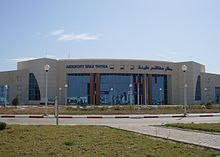
Motorways
[edit]The A1 motorway connects Sfax with Tunis and also with Gabès that was inaugurated in 2017.[41]
- Motorways :
- Projects :[42]
- National roads : (Kerkennah, Sidi Bouzid, Tataouine)
Railways
[edit]A narrow-gauge railway system of SNCFT offers passenger services to Tunis and delivers phosphates and iron ore for export.
Airports
[edit]Sfax is served by Sfax–Thyna International Airport and Syphax Airlines has regularly scheduled flights to Paris-Charles de Gaulle Airport, Montréal–Pierre Elliott Trudeau International Airport, Sabiha Gökçen International Airport, Tripoli International Airport, and charter flights to Jeddah Airport for the pilgrimage to Mecca.
Media
[edit]Founded in 1961, Radio Sfax broadcasts twenty hours a day[43] on MW 720 kHz/105.21 MHz.[44]
There is also:
- Al Qalam TV
- Diwan FM[45]
- Chams El-Janoub, hebdomadaire arabophone[46]
- La Gazette du Sud, mensuel francophone[47]
Sport
[edit]Sfax has three sports clubs, for football, volleyball and basketball: CS Sfaxien, Sfax Railway Sport, Stade Sportif Sfaxien:
| Club | Stadium | Foundation | Football championships |
Volleyball championships |
Basketball championships |
|---|---|---|---|---|---|
| Club Sportif Sfaxien | Stade Taïeb Mhiri | 1928 | 8 | 11 | 19 (women's) |
| Sfax Railways Sports | Stade Ameur-El Gargouri | 1920 | 3 | 2 | 1 |
| Stade Sportif Sfaxien | Stade 2-Mars | 1960 | 0 | – | – |
Notable people
[edit]- Ahmed Abbes, mathematician
- Ali Abdi, professional footballer
- Max Azria, fashion designer
- Mamdouh Bahri, artist, composer, jazz guitarist, and teacher
- Hédi Bouraoui, poet and writer
- Nouri Bouzid, film director
- Hamdi Braa, basketball player
- Mohamed Charfi, academic, politician, jurist, and scholar
- Eoin Colfer, Irish author; worked in Sfax in the 1990s and set several of his books there
- Aymen Dahmen, professional footballer
- Moncef Dhouib, director and screenwriter
- Luciano Di Napoli (Sfax born), Italian pianist and conductor
- Tom Dixon, industrial designer
- Serge Dumont, business executive
- Mohamed Fourati, surgeon
- Mohamed Gouaida, footballer
- Farhat Hached, trade union leader assassinated by the French government
- Mohamed Jamoussi, artist, poet, composer, and famous singer
- Claude Kayat, Franco-Swedish writer and dramatist
- Mounir Laroussi, scientist, inventor
- Christian Lauba, composer
- Ali Maâloul, professional footballer
- Abdessalem Mseddi, former Minister of Higher Education, linguist, and writer
- Georges Perec, writer
- Hatem Trabelsi, former football player
- Saber Rebaï, Tunisian pan-Arab singer and composer
- Majida Boulila, Militant
- Mounir Lazzez, UFC Fighter
International relations
[edit]This section needs additional citations for verification. (October 2015) |
Twin towns – sister cities
[edit]Sfax is twinned with:
 Grenoble, France[48]
Grenoble, France[48] Makhachkala, Russia
Makhachkala, Russia Marburg, Germany[49]
Marburg, Germany[49] Dakar, Senegal
Dakar, Senegal Oran, Algeria
Oran, Algeria Safi, Morocco
Safi, Morocco
Gallery
[edit]See also
[edit]- Fossa regia
- Sfax War Cemetery
- Sufax, a possible etymon of Sfax
- Transport in Tunisia
References
[edit]- ^ Dumper, Michael; Stanley, Bruce E. (2007). Cities of the Middle East and North Africa : a historical encyclopedia. Santa Barbara, Calif.: ABC-CLIO. ISBN 978-1-57607-920-1. OCLC 80014324.
- ^ "Biggest Cities In Tunisia". WorldAtlas. Retrieved 10 July 2018.
- ^ a b "Sfax".
- ^ Randier, Jean (2006). La Royale. Babouji. p. 395. ISBN 2-35261-022-2.
- ^ Randier 2006, p. 395.
- ^ "Les normales climatiques en Tunisie entre 1981 2010" (in French). Ministère du Transport. Archived from the original on 19 December 2019. Retrieved 26 December 2019.
- ^ "Données normales climatiques 1961–1990" (in French). Ministère du Transport. Archived from the original on 21 December 2019. Retrieved 26 December 2019.
- ^ "Les extrêmes climatiques en Tunisie" (in French). Ministère du Transport. Archived from the original on 21 December 2019. Retrieved 26 December 2019.
- ^ "Période ensoleillée 1981-2010 climatiques en Tunisie" (in French). Ministère du Transport. Retrieved 26 December 2019.
- ^ "Réseau des stations météorologiques synoptiques de la Tunisie" (in French). Ministère du Transport. Retrieved 26 December 2019.
- ^ "Sfax Climate Normals 1961–1990". National Oceanic and Atmospheric Administration. Retrieved 24 January 2015.
- ^ "Climate Normals 1991-2020". NOAA.gov. National Oceanic and Atmospheric Administration. Retrieved 18 September 2018.
- ^ "60750: Sfax El-Maou (Tunisia)". ogimet.com. OGIMET. 14 December 2022. Retrieved 15 December 2022.
- ^ "Sfax Climate and Weather Averages, Tunisia". Weather2Travel. Retrieved 19 July 2014.
- ^ Atlas du Gouvernorat de Sfax: Page 16 (In French)
- ^ Atlas du Gouvernorat de Sfax: Page 17 (In French)
- ^ Présidents précédents (Commune de Sfax).
- ^ Résultats préliminaires (Instance supérieure indépendante pour les élections).
- ^ Recensement Général de la Population et de l'Habitat 2014 – Population, logements et ménages par commune et arrondissement [Census 2014 results – population, accommodation and households per municipality and delegation] (Report) (in French). National Institute of Statistics. 1 April 2015. Retrieved 18 February 2016.
- ^ "Sfax Population totale, 1990–2021". Knoema.fr. 13 July 2022. Retrieved 31 August 2022.
- ^ "Sfax (Municipality, Tunisia) – Population Statistics, Charts, Map and Location".
- ^ a b "Les origines". sfax1881-1956.com. Retrieved 10 January 2018.
- ^ Bensalah, Moncef. "Les portes de la Médina". lesitesfaxien.net (in French). Archived from the original on 16 October 2017. Retrieved 16 February 2018.
- ^ "Kasbah of Sfax".
- ^ "City Hall | Commune de Sfax".
- ^ : See Culture
- ^ enis.rnu.tn
- ^ escs.rnu.tn
- ^ flshs.rnu.tn
- ^ fmsf.rnu.tn Archived 5 April 2007 at the Wayback Machine
- ^ isaas.rnu.tn
- ^ fsegs.rnu.tn
- ^ "Home". fss.rnu.tn.
- ^ isimsf.rnu.tn
- ^ fdsf.rnu.tn
- ^ "North American Private University". Networking Academy. 12 April 2018.
- ^ « Le festival international de Sfax revient pour sa 42e édition », Tunisie.co, 24 juillet 2020.
- ^ : Maison de France of Sfax
- ^ : See Economy
- ^ "Gouvernorat de Sfax". Tunisieindustrie.nat.tn. 17 January 2017. Retrieved 31 August 2022.
- ^ "Autoroute Tunisie : Sfax-Gabès enfin opérationnelle". 29 August 2017.
- ^ "Equipement: De grands projets routiers en 2022". 6 January 2022.
- ^ Jeter, James Phillip; Rampal, Kuldip R.; Cambridge, Vibert C.; Pratt, Cornelius B. (1996). International Afro mass media: a reference guide. Westport, CT: Greenwood Publishing Group. p. 130. ISBN 0-313-28400-8. Retrieved 1 January 2011.
- ^ Radio Tunis (2010). "Radio Sfax, official site". Radiodiffusion Television Tunisienne. Archived from the original on 21 August 2010. Retrieved 1 January 2011.
- ^ "La Haica accorde des licences à Al-Janoubia TV et 6 radios". kapitalis.com (in French). 21 April 2015. Retrieved 11 May 2020.
- ^ "Chams El-Janoub". news.chamseljanoub.tn (in Arabic). Retrieved 3 November 2020.
- ^ "La Gazette du Sud". news.lagazettedusud.tn (in French). Retrieved 3 November 2020.
- ^ Jérôme Steffenino, Marguerite Masson. "Ville de Grenoble –Coopérations et villes jumelles". Grenoble.fr. Retrieved 16 May 2013.
- ^ "Universitätsstadt Marburg Partnerstädte". marburg.de. Retrieved 20 March 2011.
Notes
[edit]External links
[edit] Sfax travel guide from Wikivoyage
Sfax travel guide from Wikivoyage- Sfaxonline.com
- Histoiredesfax.com
- CSS.org.tn


